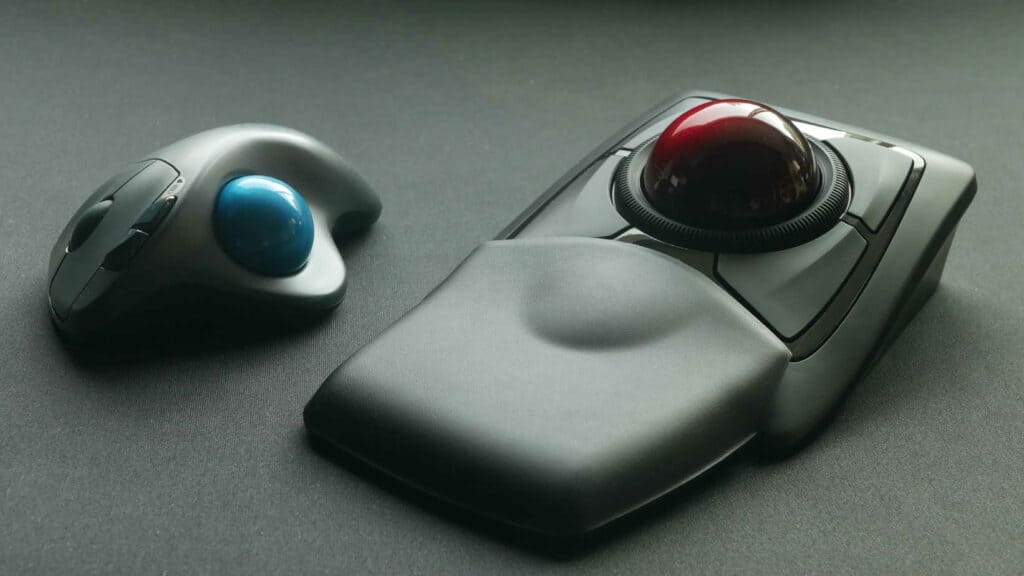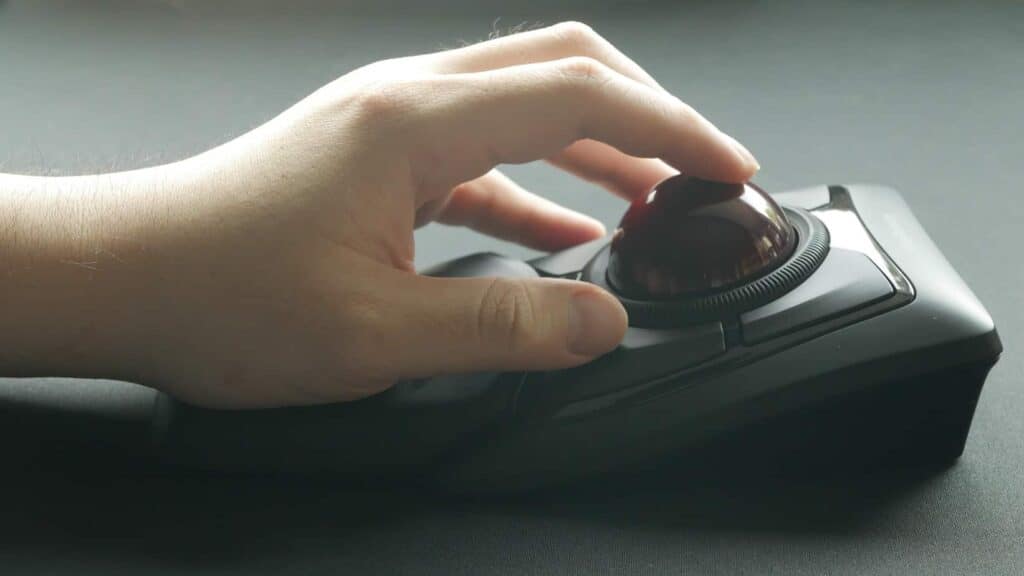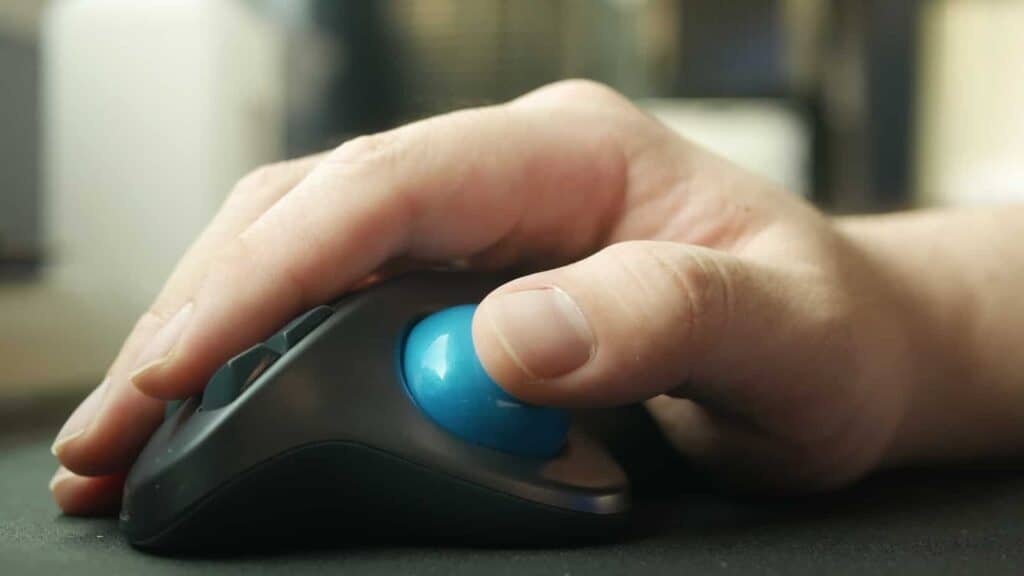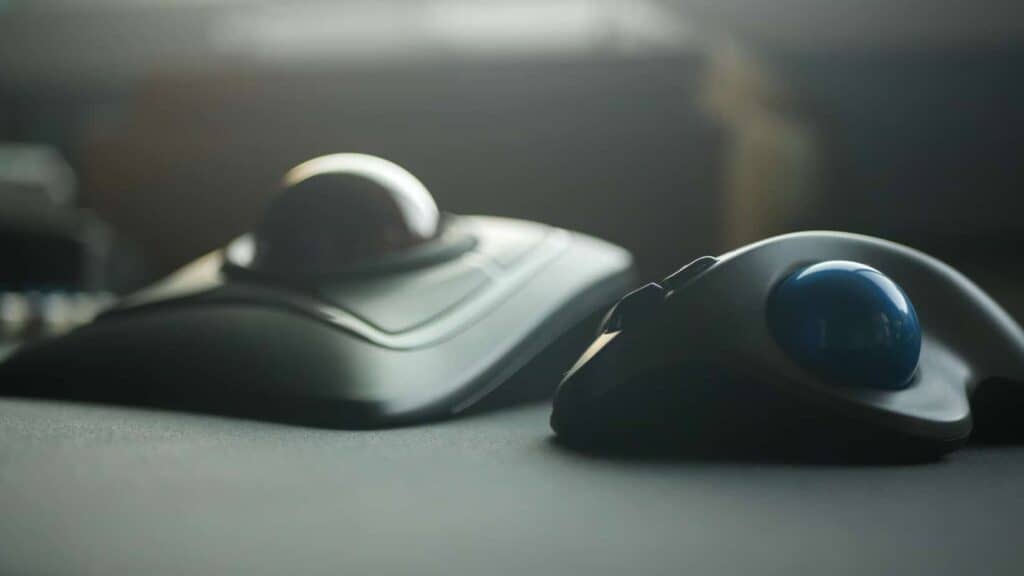If you’re looking for trackball mice, you might notice there are two main differences: some use your thumb to move the trackball, and others use your fingers.
While thumb trackballs tend to be more ergonomic and familiar to hold for some those used to a regular mouse, a finger-operated trackball might offer more options and accessibility.
Whether you want to game, become more productive, or just be online all day, there could be a good trackball for you.
With such different designs, let’s take a closer look at what else separates thumb and finger-controlled trackballs.

What’s the Difference Between a Thumb and Finger Trackball?
| Thumb Trackball | Finger Trackball |
|---|---|
| Side-Mount | Top-Mount |
| Roll trackball with Thumb | Roll trackball with Fingers |
| Small Trackball Size | Larger Trackball Size |
| Ergonomic Design | Typically Ambidextrous Design |
| Buttons in More Traditional Layout | Buttons Arranged Around Trackball |
| More Familiar for Gaming | More Options for Productivity |
| Lower Accessibility | Higher Accessibility |
The Design and Ergonomics

Design is the most obvious difference between these two trackballs. The main differences are trackball position , shape, and number of buttons.
A thumb-operated trackball has a side-mounted ball, and is typically more ergonomic, designed to fit naturally in the shape of either the right or left hand.
The curved shape fits your hand’s contours, and allows your hand to rest in a more natural and less pronated position. They are often the same size as a regular ergonomic mouse.
They even allow for the same “grip-styles” as a regular mouse or gaming mouse. Even if you have a large hand, you can hold one of these in your palm very naturally.
A finger-operated trackball features a top-mounted trackball design. They tend to be ambidextrous and larger in overall size, though there are also ergonomic options as well.
The top-mounted trackball allows you to use one or two fingers to operate the trackball, as well as click buttons. This allows for more buttons and greater productivity and functionality in a mouse.
Having a trackball in the center also means more options on how to control the ball. One-handed, two-handed, and more creative options are all possible.
To find out more about why hand position and ergonomics are so important, study up with our guide to ergonomics.
The Trackball Size
Side-mounted trackballs tend to be smaller in diameter, because your thumb has a much smaller range of motion than your fingers and wrists.
This makes them potentially easier to control than a larger top-mount trackball, but less precise.
Side-mounted trackballs could potentially put more strain on your thumb and its joints than finger-operated balls.
Top-mounted trackballs come in a range of sizes, typically much larger than thumb-controlled balls.
This also means you may have to use two fingers, or added wrist/forearm motion to achieve the same cursor movement.
They tend to be more precise as it has more surface area, but may also take more effort to control.
Top-mounted trackballs could potentially put more strain on your fingers and wrist than thumb-operated balls.
Righty vs Lefty

Side-mounted trackballs are made for use with a thumb, and therefore have to designed to fit either a right-hand or a left hand, but not both.
This also means that there are, unfortunately, a greater number of right-handed designs. If you’re a lefty, your options here are limited.
Top-mounted trackballs are made to be finger-operated, but come in both ergonomic and ambidextrous designs.
It doesn’t matter whether you are righty, lefty, or need something with greater accessibility, because ambidextrous trackballs can be used in a variety of ways than simply with your thumb.
Accessibility and Ease of Use
So far we have been discussing right hands vs left hands, and thumbs vs fingers.
What if we don’t have the luxury of those? What if we need an option that doesn’t require “dexterity” at all?
That is where trackballs come in. With a trackball, you are not expected to grasp or hold anything to move the cursor like a traditional mouse.
The ball just needs to be rolled somehow. Buttons just need to be clicked.
With many “finger-operated” top-mount trackballs, the buttons are large and oriented in a convenient manner. The designs are able to accommodate a wider range of use-cases.
While “thumb” or “finger-operated” is the more common terminology, perhaps a more accurate and appropriate description would be “top-mounted” and “side-mounted” trackball.
But that is a discussion for another day.
Which Style is Better?
For Gaming: Side Mount

A side-mounted trackball will be the preferred option for most cases,
This is especially true if you are more comfortable using a gaming mouse with a traditional button layout.
Side-mounted trackballs tend to be more ergonomic to hold, and allow you to use your index and ring fingers to control right-click, left-click, scroll, and in some cases even DPI adjustment.
This means you won’t have to take time learning a new mouse layout, on top of learning how to use a trackball.
A side-mounted trackball will also be more ideal for smaller hands in most cases. The smaller trackball means a smaller gesture can move your cursor a greater distance than a larger ball.
A larger ball may just have greater precision.
With a majority of top-mounted trackballs, you may have to adapt your hand gestures to a larger trackball and a button arrangement that can be hard to get used to when all you want to do is game.
For Productivity: Top Mount
Top-mounted trackballs are typically better for productivity simply for the fact that they are ambidextrous, and tend to have more programmable buttons for added functionality.
You can use it with a fullsize keyboard or southpaw keyboard on either side, or even in a stacked configuration like you might use a laptop’s trackpad.
For Casual Use: Preference
Obviously for casual use, this is completely up to personal preference and needs.
While a side-mounted trackball gives you a more natural angle in your wrists for RSI prevention, a top-mounted trackball can give you more ease-of-use by being a more universal design and having more buttons to customize.
Interested in how position and placement can affect your health and comfort, check out this guide on the best keyboard and mouse positions.
For Increased Accessibility: Top Mount
The top-mounted trackball is the undisputed winner for accessibility. For those who simply can’t use a regular mouse as a pointing device, the top-mounted trackball presents an option to use a mouse that is both affordable and widely available.
The large diameter trackball and top-mounted position make it incredibly easy to use with a variety of options and solutions.
With the globe located centrally on a large housing, the buttons are typically arranged around the trackball to make them more convenient to reach and use.
The buttons’ functions are also often customizeable and programmable, so you can create your own easy-to-use layout.
If a regular mouse wasn’t an option for you before, perhaps a trackball can point you in the right direction.
Budget Trackballs to Consider
If you’re new to trackballs, you might want to try one out without breaking the bank. Here two great budget options you can consider:
Logitech M570
A proven favorite in the trackball world for over 10 years, the Logitech M570 is a wireless, ergonomic, right-handed thumb-operated trackball mouse.
It might not be the smoothest option, but it is simple, reliable, and feels great even for larger hands.
To find out more about this trackball mainstay, read the full review here!
Find it for a great price on Amazon.
Kensington Orbit with Scroll Ring
A well known brand in the trackball world, Kensington’s Orbit Trackball is a budget-minded, ambidextrous finger-operated trackball.
It has a larger diameter trackball than the M570 above and features an ergonomic scroll-ring rather than a scroll wheel, but fewer buttons.
An option with high accessibility. There is also a wireless version for a snazzier setup.
Find it for a great price on Amazon.
Conclusion

With options like trackball position, trackball size, ergonomics, and accessible design, trackballs give you the freedom to choose what fits your needs the best
Whether you want to be working hard or hardly working, there is a trackball that will help you reach your goals.
Thumb? Finger? Neither? Any way you roll, you can’t go wrong with a trackball mouse.
Side mount? Top Mount? Any way you go, we hope this helped you decide what your favorite position is.
Thank you for reading, and hope you’re having a trackball!
